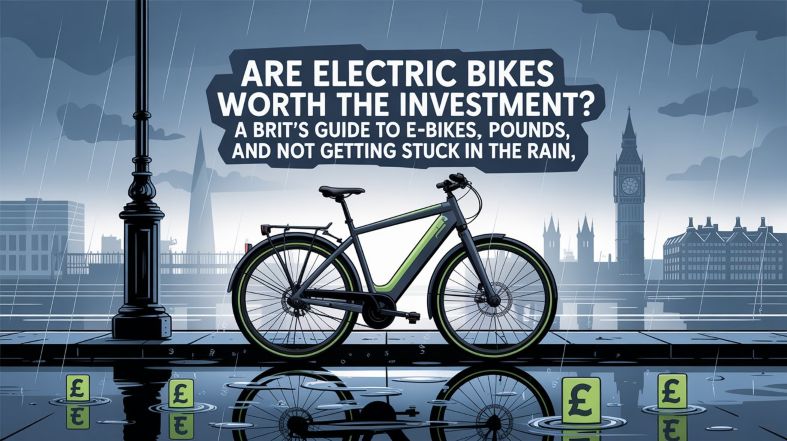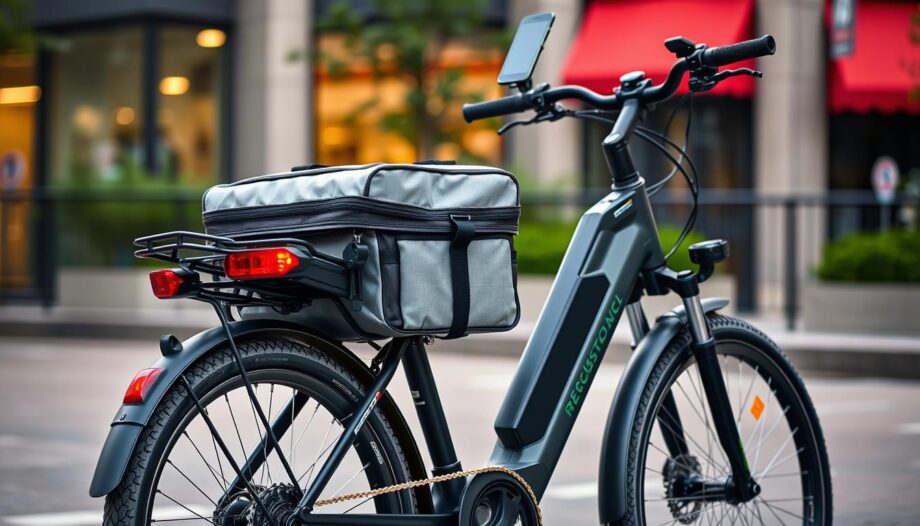Imagine my excitement when I first laid eyes on an electric bike it was like seeing Niagara Falls, only to realize I hadn’t packed a raincoat. There I was, heart soaring at the sight of these futuristic marvels, only for my wallet to implode quicker than a soufflé at a bass drum concert. Welcome to the elite club of electric bikes, where the price tags are as beefy as the tech is sleek. In this blog post, we’re going to spelunk into the cavernous depths of their super-sized costs and unearth the hidden, and not-so-tiny, factors behind those eye-watering price tags. So, brew a strong cuppa, folks it’s time to decode the financial enigma of e-bikes
Why do these shiny two-wheelers cost as much as a small island, you ask? Well, it’s a cocktail of reasons: the motors are more pampered in production than a diva in a spa, the batteries are so light you’d think they were on a diet, and there’s less competition than in a one-man race. Let’s not forget, they’re made with components so high-quality, that they probably have a higher IQ than both of us. And because it’s still a bit of a niche market, it’s like trying to buy flour in a gluten-free store choices are limited, and you’ll pay through the nose. Plus, the ongoing expenses of charging these beasts and swapping batteries are like adding a subscription service to your already strained bank account. But hold onto your helmets—there’s hope! As these electric stallions gallop into mainstream hearts, the prices might just drop as competition and production ramp up. Hang tight; affordability may be just over the next hill!

Hidden Factors Behind High Prices
While advanced battery packs play a significant role in driving up electric bike prices, there are also hidden factors at play that contribute to their high costs. Let’s explore some of these factors:
- Research and Development: Electric bike manufacturers invest heavily in research and development to design cutting-edge models that meet consumer demands and improve overall performance. This includes incorporating innovative features such as advanced motor technology, smart connectivity options, and lightweight frame materials. The expenses incurred during the R&D phase ultimately get factored into the retail price.
- Supply Chain Complexity: The complex supply chain involved in manufacturing electric bikes also impacts pricing. From sourcing quality components, including motors, frames, and electrical systems, to assembly and distribution processes, each step incurs costs. Additionally, global events like trade disputes or natural disasters can disrupt the supply chain and result in price fluctuations.
- Specialised Manufacturing: Unlike traditional bicycles that are mass-produced, electric bikes often require more specialised manufacturing techniques due to their intricate electrical components. This specialisation adds complexity and expense or overhead cost to the production process compared to conventional bikes.
- Limited Production Volume: Electric bikes, particularly those with advanced features, cater to a niche market that hasn’t reached the scale of traditional bicycle production. The lower demand and limited economies of scale contribute to higher costs per unit, which get passed on to consumers.
It’s important to acknowledge that lingering external factors also affect pricing. Global events impacting material costs, like fluctuations in commodity prices or disruptions in the supply chain due to unforeseen circumstances, can further elevate electric bike prices, also the cost of hiring people to construct the bikes, and the labour costs.
Take into consideration the impact of the COVID-19 pandemic on the bike industry. Supply chain disruptions, increased shipping costs, and high demand for outdoor activities caused by lockdown restrictions led to shortages and inflated prices across the industry.
While electric bikes may seem expensive upfront, it’s crucial to evaluate the long-term benefits they offer – reduced commuting expenses, environmental friendliness, and improved fitness opportunities. As technology advances and demand grows, manufacturing efficiencies might drive down costs in the future.
Also as a seller of these types of bikes, you have to make a profit, and factor in the cost of support of the people who buy your bikes, this is an overhead cost that is hidden when people buy anything, especially online.

Components Driving up the Cost of Electric Bicycles
Electric bikes have gained significant popularity in recent years, offering a convenient and environmentally friendly mode of transportation. However, the cost of electric bikes can often be higher than that of traditional bicycles. This is primarily due to several components that contribute to their advanced technology and overall performance. Let’s explore some of these components that drive up the cost.
Firstly, one of the main factors behind the expense of electric bikes is the advanced battery packs they utilise. These battery packs are designed to provide sufficient power to the electric motor for longer durations, allowing riders to cover greater distances. High-quality battery packs often incorporate lithium-ion technology, which offers improved efficiency and longevity compared to older battery types.
Additionally, advanced battery packs may feature higher voltages and larger capacities, enabling electric bikes to travel further on a single charge. These batteries undergo rigorous testing and certification processes to ensure their safety and reliability, adding to their overall cost.
Another component that impacts the price of electric bikes is the electric motor itself. Specialised motors are engineered specifically for eBikes and offer varying levels of power assistance. These motors are typically built with specialised technologies such as torque sensors or cadence sensors, which help regulate power output based on the rider’s pedalling patterns or input.
For instance, a high-end electric bike may be equipped with a mid-drive motor positioned at the bike’s centre for better weight distribution and handling. This type of motor allows for smoother power delivery and improved climbing capabilities, enhancing the overall riding experience.
The design and engineering involved in creating these specialised motors require extensive research and development. Manufacturers invest considerable time and resources into optimising their motors’ performance, resulting in higher costs associated with these components.
It’s important to note that while these two components are significant contributors to the overall cost of electric bikes, they are just a part of the picture. Other factors like frame materials, braking systems, suspension, and additional features also play a role in determining the price range of electric bikes.
Now that we have explored the components driving up the cost of electric bikes, let’s delve further into the specifics of specialised motors and how they contribute to the overall expense.
- According to a report by Grand View Research, Inc., the global e-bikes market size was estimated to be worth $23.89 billion in 2020.
- A consumer study conducted in 2020 found that 48% of the participants believe that battery and motor maintenance significantly contribute to the overall cost of an e-bike.
- Statistics from Allied Market Research project that by 2025, the cost of battery technology, one of the most expensive components of an e-bike, is expected to decrease by 20%, potentially reducing the cost of e-bikes.
- Electric bikes have become increasingly popular due to their convenience and eco-friendliness, but they often come with a higher price tag compared to traditional bicycles. One of the main factors contributing to this cost is the advanced battery packs used in electric bikes. These battery packs are designed to provide longer-lasting power and often incorporate lithium-ion technology for improved efficiency and longevity. They also undergo rigorous testing and certification processes, adding to their overall expense.
Another component that impacts the price of electric bikes is the specialised electric motor. These motors are engineered specifically for eBikes and offer varying levels of power assistance. They are built with specialised technologies such as torque sensors or cadence sensors to regulate power output based on the rider’s pedalling patterns or input. Some high-end electric bikes may even feature mid-drive motors positioned at the bike’s centre for better weight distribution and handling, resulting in a smoother riding experience.
The design and development of these specialised motors require significant investment in research and engineering, further contributing to the overall cost of electric bikes. However, it’s important to note that components like frame materials, braking systems, suspension, and additional features also play a role in determining the price range of electric bikes.
In conclusion, while advanced battery packs and specialised motors drive up the cost of electric bikes, they are just part of the overall picture. Understanding these components can help consumers make informed decisions when considering an electric bike purchase.
Specialised Motors
Electric bike motors play a vital role in providing power assistance to riders. Specialised motors are designed specifically for eBikes, incorporating advanced technologies to enhance performance and riding dynamics. These motors not only provide smooth power delivery but also offer varying levels of assistance based on the rider’s pedalling input.
One type of specialised motor frequently found in electric bikes is the mid-drive motor. Positioned at the bike’s centre, this type of motor offers several advantages over other motor placements. The mid-drive motor allows for better weight distribution across the frame, resulting in improved stability and manoeuvrability while riding. It also makes it possible to optimise the bike’s balance and handling characteristics, ensuring a more natural and comfortable riding experience.
Imagine riding an electric bike equipped with a mid-drive motor while travelling uphill. The motor’s position at the centre of the bike helps maintain balance, making it easier to navigate challenging terrain without feeling off-balance or straining yourself excessively.
Moreover, mid-drive motors often incorporate advanced features such as torque sensors or cadence sensors. These sensors detect the rider’s pedalling force or rotational speed and adjust the assistance level accordingly. This intelligent power modulation ensures a seamless and responsive riding experience by providing just the right amount of assistance when needed.
It’s worth noting that specialised motors require extensive research and development to meet specific performance requirements and efficiency standards in various types of electric bikes. This dedication to engineering excellence contributes significantly to their higher cost compared to standard motors used in traditional bicycles.
Having explored specialised motors and their role in enhancing electric bike performance, we now have a better understanding of why these components contribute to the overall expense. However, there are additional factors at play that justify the higher cost, including advanced battery technology and design considerations.
If you want to learn more about electric bike motor technology you can here
Advanced Battery Packs
One of the primary reasons for the high cost of electric bikes lies in the advanced battery packs they utilise. Unlike traditional bicycles, electric bikes rely on powerful batteries to provide the necessary boost and enhance the riding experience. These battery packs are specifically designed for the demands of electric bikes, requiring high-capacity cells that can deliver consistent performance and withstand frequent charge cycles.
Picture a premium electric bike with an advanced lithium-ion battery pack. These high-quality batteries are built with longevity and reliability in mind, allowing riders to travel longer distances without worrying about running out of power. The technology and specialised components incorporated into these battery packs significantly contribute to their cost.
Producing these advanced battery packs involves extensive research, development, and testing to ensure optimal performance and safety. Manufacturers invest significant resources in sourcing high-quality materials, designing efficient cooling systems, and integrating sophisticated battery management systems (BMS) that protect against overcharging, overheating, and other potential hazards.
Moreover, one must consider the costs associated with meeting strict regulatory standards governing battery production. Compliance with safety requirements further drives up the cost of these intricate power sources. As such, the advanced battery packs are a substantial contributing factor to the overall expense of electric bikes.
More about electric bike battery tech here.
Why do E-Bikes Cost More Than Traditional Bikes?
It’s no secret that electric bikes come with a higher price tag compared to their traditional counterparts. But why is this the case? Let’s explore the factors that contribute to the higher cost of electric bikes.
Firstly, the most apparent reason for the higher cost is the inclusion of an electric motor and battery system. These components are essential for powering the bike and providing assistance to the rider. The motor itself needs to be durable, powerful, and capable of maintaining consistent performance over time. Additionally, quality batteries that offer a decent range and lifespan can be expensive to manufacture.
Secondly, electric bikes often incorporate advanced technology and features. From integrated LCD displays to sophisticated control systems, these modern additions enhance the riding experience and improve safety. However, incorporating such technology into the design comes at a higher cost. R&D investments, testing, and ongoing improvements all contribute to the overall price of the electric bike.
Imagine purchasing a traditional bike versus an electric bike. While a traditional bike may have a simpler design with minimal features, an electric bike offers enhanced functionalities like pedal-assist modes, multiple speed settings, regenerative braking systems, and even smartphone connectivity. These added features not only improve convenience but also increase the complexity of manufacturing, ultimately adding to costs.
Furthermore, electric bikes often require high-quality components to withstand the additional strain placed on them by the motorised system. This includes stronger frames to handle the increased weight and provide stability during faster speeds or rough terrain. Upgraded suspensions, reliable braking systems, and specialised gear systems are also common features found in electric bikes. These components are typically more expensive due to their increased durability and performance requirements.
Lastly, economies of scale also influence pricing. Electric bikes are still relatively new in comparison to traditional bicycles, resulting in lower production volumes. As demand increases and more manufacturers enter the market, prices are expected to become more competitive. Additionally, as technology advances and becomes more mainstream, production costs are likely to decrease, leading to more affordable electric bikes in the future.
How do electric bike prices compare to traditional bicycles?
Electric bike prices are generally higher than those of traditional bicycles. The inclusion of the electric motor and battery significantly adds to the production costs. According to a study by Deloitte, in 2020, the average price of an electric bike was around $2,000, while traditional bicycles had an average price of $500. Additionally, the complexity of the electrical components and the limited market demand for electric bikes contribute to higher manufacturing costs.
Are there any budget-friendly options for ebikes?
Yes, there are budget-friendly options for electric bikes available in the market. While high-end electric bikes can be expensive due to advanced features and premium components, there are several brands that offer more affordable models without compromising on quality. According to a 2022 study by Navigant Research, the average price of an electric bike has decreased significantly over the past few years, making it more accessible to a wider range of consumers. Additionally, some companies offer financing options or discounts on previous year’s models, further reducing the cost for budget-conscious buyers.
Are there any benefits that justify the higher price of electric bikes?
Yes, there are several benefits that justify the higher price of electric bikes. Firstly, electric bikes offer a more eco-friendly mode of transportation since they produce zero emissions. Secondly, they provide a convenient and efficient way to commute, especially in urban areas where traffic congestion is an issue. Additionally, electric bikes promote physical activity as riders still need to pedal despite having assistance from the motor. Several studies have shown that electric bike riders tend to be more physically active than traditional bike riders. Finally, owning an electric bike can result in long-term cost savings, as they require less maintenance and have lower fuel costs compared to cars. Recent statistics indicate that the average annual maintenance cost of an electric bike is around $100, significantly lower than the average annual maintenance cost of a car, which is approximately $1,200.
What components contribute to the high cost of electric bikes?
Several factors contribute to the high cost of electric bikes. Firstly, the battery is a significant component, accounting for a substantial portion of the overall cost. High-quality lithium-ion batteries used in electric bikes are expensive due to their advanced technology and durability. Additionally, electric bikes require specialised motors and controllers, which further add to the cost. The integration of these components with the frame design, as well as the use of high-quality drivetrain and braking systems, also contribute to the overall price. Finally, the limited production scale compared to traditional bicycles keeps manufacturing costs higher. However, it’s worth noting that as the demand for electric bikes increases and technology advances, economies of scale can drive down prices in the future.
Are there any ways to reduce the cost of purchasing an electric bike?
Yes, there are several ways to reduce the cost of purchasing an electric bike. Firstly, consider buying a used or refurbished electric bike instead of a brand-new one, as this can save a significant amount of money. Secondly, look for deals and discounts offered by manufacturers or retailers, especially during sales events like Black Friday. Additionally, opting for a basic model without extra features or high-end components can help lower the cost. Lastly, considering the long-term savings on fuel and maintenance costs, investing in an electric bike becomes more affordable over time. According to research, electric bikes can save riders up to $3000 annually in transportation expenses compared to owning a car.





